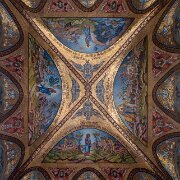
1 Biserica Veche a Mitropoliei, also known as the Old Metropolitan Church, is one of the most significant historical and religious landmarks in Bucharest, Romania. Originally constructed in the mid-17th century under the patronage of Prince Constantin Șerban, the church served as the religious heart of Wallachia, becoming the seat of the Romanian Orthodox Metropolitan. Completed in 1658, it stands as a symbol of the consolidation of Romanian ecclesiastical power and national identity. Throughout its history, the church has witnessed numerous political and religious events, including coronations and declarations of national unity. Despite periods of damage from earthquakes and political turmoil, the structure has been carefully restored and preserved, maintaining its central role in Romania's spiritual and cultural life.
Architecturally, Biserica Veche a Mitropoliei is a prime example of the Brâncovenesc style, a uniquely Romanian architectural form that blends Byzantine, Ottoman, and Western Renaissance elements. The church features a harmonious façade with intricately carved stone columns and ornamental details, as well as a distinct bell tower and richly frescoed interior. Its layout follows the traditional Orthodox triconch plan, with a central dome symbolizing the heavens. Inside, the church houses a remarkable collection of religious icons and frescoes, many of which date back to the original construction or early restorations. The architectural and artistic significance of the church, coupled with its historical importance, makes it a treasured monument of Romanian heritage.
Architecturally, Biserica Veche a Mitropoliei is a prime example of the Brâncovenesc style, a uniquely Romanian architectural form that blends Byzantine, Ottoman, and Western Renaissance elements. The church features a harmonious façade with intricately carved stone columns and ornamental details, as well as a distinct bell tower and richly frescoed interior. Its layout follows the traditional Orthodox triconch plan, with a central dome symbolizing the heavens. Inside, the church houses a remarkable collection of religious icons and frescoes, many of which date back to the original construction or early restorations. The architectural and artistic significance of the church, coupled with its historical importance, makes it a treasured monument of Romanian heritage.
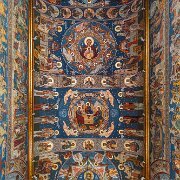
2 Biserica Veche a Mitropoliei, also known as the Old Metropolitan Church, is one of the most significant historical and religious landmarks in Bucharest, Romania. Originally constructed in the mid-17th century under the patronage of Prince Constantin Șerban, the church served as the religious heart of Wallachia, becoming the seat of the Romanian Orthodox Metropolitan. Completed in 1658, it stands as a symbol of the consolidation of Romanian ecclesiastical power and national identity. Throughout its history, the church has witnessed numerous political and religious events, including coronations and declarations of national unity. Despite periods of damage from earthquakes and political turmoil, the structure has been carefully restored and preserved, maintaining its central role in Romania's spiritual and cultural life.
Architecturally, Biserica Veche a Mitropoliei is a prime example of the Brâncovenesc style, a uniquely Romanian architectural form that blends Byzantine, Ottoman, and Western Renaissance elements. The church features a harmonious façade with intricately carved stone columns and ornamental details, as well as a distinct bell tower and richly frescoed interior. Its layout follows the traditional Orthodox triconch plan, with a central dome symbolizing the heavens. Inside, the church houses a remarkable collection of religious icons and frescoes, many of which date back to the original construction or early restorations. The architectural and artistic significance of the church, coupled with its historical importance, makes it a treasured monument of Romanian heritage.
Architecturally, Biserica Veche a Mitropoliei is a prime example of the Brâncovenesc style, a uniquely Romanian architectural form that blends Byzantine, Ottoman, and Western Renaissance elements. The church features a harmonious façade with intricately carved stone columns and ornamental details, as well as a distinct bell tower and richly frescoed interior. Its layout follows the traditional Orthodox triconch plan, with a central dome symbolizing the heavens. Inside, the church houses a remarkable collection of religious icons and frescoes, many of which date back to the original construction or early restorations. The architectural and artistic significance of the church, coupled with its historical importance, makes it a treasured monument of Romanian heritage.
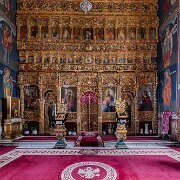
3 Biserica Veche a Mitropoliei, also known as the Old Metropolitan Church, is one of the most significant historical and religious landmarks in Bucharest, Romania. Originally constructed in the mid-17th century under the patronage of Prince Constantin Șerban, the church served as the religious heart of Wallachia, becoming the seat of the Romanian Orthodox Metropolitan. Completed in 1658, it stands as a symbol of the consolidation of Romanian ecclesiastical power and national identity. Throughout its history, the church has witnessed numerous political and religious events, including coronations and declarations of national unity. Despite periods of damage from earthquakes and political turmoil, the structure has been carefully restored and preserved, maintaining its central role in Romania's spiritual and cultural life.
Architecturally, Biserica Veche a Mitropoliei is a prime example of the Brâncovenesc style, a uniquely Romanian architectural form that blends Byzantine, Ottoman, and Western Renaissance elements. The church features a harmonious façade with intricately carved stone columns and ornamental details, as well as a distinct bell tower and richly frescoed interior. Its layout follows the traditional Orthodox triconch plan, with a central dome symbolizing the heavens. Inside, the church houses a remarkable collection of religious icons and frescoes, many of which date back to the original construction or early restorations. The architectural and artistic significance of the church, coupled with its historical importance, makes it a treasured monument of Romanian heritage.
Architecturally, Biserica Veche a Mitropoliei is a prime example of the Brâncovenesc style, a uniquely Romanian architectural form that blends Byzantine, Ottoman, and Western Renaissance elements. The church features a harmonious façade with intricately carved stone columns and ornamental details, as well as a distinct bell tower and richly frescoed interior. Its layout follows the traditional Orthodox triconch plan, with a central dome symbolizing the heavens. Inside, the church houses a remarkable collection of religious icons and frescoes, many of which date back to the original construction or early restorations. The architectural and artistic significance of the church, coupled with its historical importance, makes it a treasured monument of Romanian heritage.
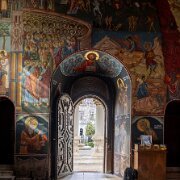
4 Biserica Veche a Mitropoliei, also known as the Old Metropolitan Church, is one of the most significant historical and religious landmarks in Bucharest, Romania. Originally constructed in the mid-17th century under the patronage of Prince Constantin Șerban, the church served as the religious heart of Wallachia, becoming the seat of the Romanian Orthodox Metropolitan. Completed in 1658, it stands as a symbol of the consolidation of Romanian ecclesiastical power and national identity. Throughout its history, the church has witnessed numerous political and religious events, including coronations and declarations of national unity. Despite periods of damage from earthquakes and political turmoil, the structure has been carefully restored and preserved, maintaining its central role in Romania's spiritual and cultural life.
Architecturally, Biserica Veche a Mitropoliei is a prime example of the Brâncovenesc style, a uniquely Romanian architectural form that blends Byzantine, Ottoman, and Western Renaissance elements. The church features a harmonious façade with intricately carved stone columns and ornamental details, as well as a distinct bell tower and richly frescoed interior. Its layout follows the traditional Orthodox triconch plan, with a central dome symbolizing the heavens. Inside, the church houses a remarkable collection of religious icons and frescoes, many of which date back to the original construction or early restorations. The architectural and artistic significance of the church, coupled with its historical importance, makes it a treasured monument of Romanian heritage.
Architecturally, Biserica Veche a Mitropoliei is a prime example of the Brâncovenesc style, a uniquely Romanian architectural form that blends Byzantine, Ottoman, and Western Renaissance elements. The church features a harmonious façade with intricately carved stone columns and ornamental details, as well as a distinct bell tower and richly frescoed interior. Its layout follows the traditional Orthodox triconch plan, with a central dome symbolizing the heavens. Inside, the church houses a remarkable collection of religious icons and frescoes, many of which date back to the original construction or early restorations. The architectural and artistic significance of the church, coupled with its historical importance, makes it a treasured monument of Romanian heritage.
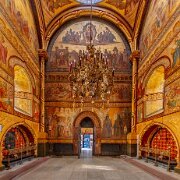
5 Mănăstirea Trei Ierarhi, or the Three Hierarchs Monastery, is one of the most important historical and religious landmarks in Iași, Romania. Founded by Prince Vasile Lupu between 1637 and 1639, the monastery was built to honor the Three Holy Hierarchs—Saint Basil the Great, Saint Gregory the Theologian, and Saint John Chrysostom. It quickly became a center of religious, cultural, and political life in Moldavia. The monastery is also notable for having housed the first printing press in Moldavia, which played a key role in the development of Romanian literature and religious thought. Vasile Lupu is buried in the monastery’s church, cementing its role as a mausoleum of the Moldavian elite.
Architecturally, Mănăstirea Trei Ierarhi is renowned for its intricate and unique stone façade, which blends Gothic, Renaissance, and Byzantine elements. The entire exterior of the church is covered with over 30 registers of decorative motifs carved in stone, showcasing a fusion of Eastern and Western styles that was unprecedented in Moldavian architecture. This ornamental richness gives the building a lace-like appearance, often compared to the elaborate stonework seen in Islamic and Armenian religious architecture. The interior, while more subdued, complements the exterior's grandeur with frescoes and iconography that reflect the Orthodox tradition. The monastery has undergone several restorations over the centuries, especially after suffering damage in earthquakes and wars, but it continues to stand as a masterpiece of Romanian ecclesiastical architecture.
Architecturally, Mănăstirea Trei Ierarhi is renowned for its intricate and unique stone façade, which blends Gothic, Renaissance, and Byzantine elements. The entire exterior of the church is covered with over 30 registers of decorative motifs carved in stone, showcasing a fusion of Eastern and Western styles that was unprecedented in Moldavian architecture. This ornamental richness gives the building a lace-like appearance, often compared to the elaborate stonework seen in Islamic and Armenian religious architecture. The interior, while more subdued, complements the exterior's grandeur with frescoes and iconography that reflect the Orthodox tradition. The monastery has undergone several restorations over the centuries, especially after suffering damage in earthquakes and wars, but it continues to stand as a masterpiece of Romanian ecclesiastical architecture.
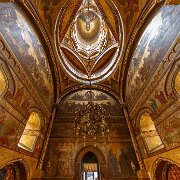
6 Mănăstirea Trei Ierarhi, or the Three Hierarchs Monastery, is one of the most important historical and religious landmarks in Iași, Romania. Founded by Prince Vasile Lupu between 1637 and 1639, the monastery was built to honor the Three Holy Hierarchs—Saint Basil the Great, Saint Gregory the Theologian, and Saint John Chrysostom. It quickly became a center of religious, cultural, and political life in Moldavia. The monastery is also notable for having housed the first printing press in Moldavia, which played a key role in the development of Romanian literature and religious thought. Vasile Lupu is buried in the monastery’s church, cementing its role as a mausoleum of the Moldavian elite.
Architecturally, Mănăstirea Trei Ierarhi is renowned for its intricate and unique stone façade, which blends Gothic, Renaissance, and Byzantine elements. The entire exterior of the church is covered with over 30 registers of decorative motifs carved in stone, showcasing a fusion of Eastern and Western styles that was unprecedented in Moldavian architecture. This ornamental richness gives the building a lace-like appearance, often compared to the elaborate stonework seen in Islamic and Armenian religious architecture. The interior, while more subdued, complements the exterior's grandeur with frescoes and iconography that reflect the Orthodox tradition. The monastery has undergone several restorations over the centuries, especially after suffering damage in earthquakes and wars, but it continues to stand as a masterpiece of Romanian ecclesiastical architecture.
Architecturally, Mănăstirea Trei Ierarhi is renowned for its intricate and unique stone façade, which blends Gothic, Renaissance, and Byzantine elements. The entire exterior of the church is covered with over 30 registers of decorative motifs carved in stone, showcasing a fusion of Eastern and Western styles that was unprecedented in Moldavian architecture. This ornamental richness gives the building a lace-like appearance, often compared to the elaborate stonework seen in Islamic and Armenian religious architecture. The interior, while more subdued, complements the exterior's grandeur with frescoes and iconography that reflect the Orthodox tradition. The monastery has undergone several restorations over the centuries, especially after suffering damage in earthquakes and wars, but it continues to stand as a masterpiece of Romanian ecclesiastical architecture.
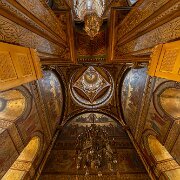
7 Mănăstirea Trei Ierarhi, or the Three Hierarchs Monastery, is one of the most important historical and religious landmarks in Iași, Romania. Founded by Prince Vasile Lupu between 1637 and 1639, the monastery was built to honor the Three Holy Hierarchs—Saint Basil the Great, Saint Gregory the Theologian, and Saint John Chrysostom. It quickly became a center of religious, cultural, and political life in Moldavia. The monastery is also notable for having housed the first printing press in Moldavia, which played a key role in the development of Romanian literature and religious thought. Vasile Lupu is buried in the monastery’s church, cementing its role as a mausoleum of the Moldavian elite.
Architecturally, Mănăstirea Trei Ierarhi is renowned for its intricate and unique stone façade, which blends Gothic, Renaissance, and Byzantine elements. The entire exterior of the church is covered with over 30 registers of decorative motifs carved in stone, showcasing a fusion of Eastern and Western styles that was unprecedented in Moldavian architecture. This ornamental richness gives the building a lace-like appearance, often compared to the elaborate stonework seen in Islamic and Armenian religious architecture. The interior, while more subdued, complements the exterior's grandeur with frescoes and iconography that reflect the Orthodox tradition. The monastery has undergone several restorations over the centuries, especially after suffering damage in earthquakes and wars, but it continues to stand as a masterpiece of Romanian ecclesiastical architecture.
Architecturally, Mănăstirea Trei Ierarhi is renowned for its intricate and unique stone façade, which blends Gothic, Renaissance, and Byzantine elements. The entire exterior of the church is covered with over 30 registers of decorative motifs carved in stone, showcasing a fusion of Eastern and Western styles that was unprecedented in Moldavian architecture. This ornamental richness gives the building a lace-like appearance, often compared to the elaborate stonework seen in Islamic and Armenian religious architecture. The interior, while more subdued, complements the exterior's grandeur with frescoes and iconography that reflect the Orthodox tradition. The monastery has undergone several restorations over the centuries, especially after suffering damage in earthquakes and wars, but it continues to stand as a masterpiece of Romanian ecclesiastical architecture.

8 Mănăstirea Trei Ierarhi, or the Three Hierarchs Monastery, is one of the most important historical and religious landmarks in Iași, Romania. Founded by Prince Vasile Lupu between 1637 and 1639, the monastery was built to honor the Three Holy Hierarchs—Saint Basil the Great, Saint Gregory the Theologian, and Saint John Chrysostom. It quickly became a center of religious, cultural, and political life in Moldavia. The monastery is also notable for having housed the first printing press in Moldavia, which played a key role in the development of Romanian literature and religious thought. Vasile Lupu is buried in the monastery’s church, cementing its role as a mausoleum of the Moldavian elite.
Architecturally, Mănăstirea Trei Ierarhi is renowned for its intricate and unique stone façade, which blends Gothic, Renaissance, and Byzantine elements. The entire exterior of the church is covered with over 30 registers of decorative motifs carved in stone, showcasing a fusion of Eastern and Western styles that was unprecedented in Moldavian architecture. This ornamental richness gives the building a lace-like appearance, often compared to the elaborate stonework seen in Islamic and Armenian religious architecture. The interior, while more subdued, complements the exterior's grandeur with frescoes and iconography that reflect the Orthodox tradition. The monastery has undergone several restorations over the centuries, especially after suffering damage in earthquakes and wars, but it continues to stand as a masterpiece of Romanian ecclesiastical architecture.
Architecturally, Mănăstirea Trei Ierarhi is renowned for its intricate and unique stone façade, which blends Gothic, Renaissance, and Byzantine elements. The entire exterior of the church is covered with over 30 registers of decorative motifs carved in stone, showcasing a fusion of Eastern and Western styles that was unprecedented in Moldavian architecture. This ornamental richness gives the building a lace-like appearance, often compared to the elaborate stonework seen in Islamic and Armenian religious architecture. The interior, while more subdued, complements the exterior's grandeur with frescoes and iconography that reflect the Orthodox tradition. The monastery has undergone several restorations over the centuries, especially after suffering damage in earthquakes and wars, but it continues to stand as a masterpiece of Romanian ecclesiastical architecture.

9 Mănăstirea Trei Ierarhi, or the Three Hierarchs Monastery, is one of the most important historical and religious landmarks in Iași, Romania. Founded by Prince Vasile Lupu between 1637 and 1639, the monastery was built to honor the Three Holy Hierarchs—Saint Basil the Great, Saint Gregory the Theologian, and Saint John Chrysostom. It quickly became a center of religious, cultural, and political life in Moldavia. The monastery is also notable for having housed the first printing press in Moldavia, which played a key role in the development of Romanian literature and religious thought. Vasile Lupu is buried in the monastery’s church, cementing its role as a mausoleum of the Moldavian elite.
Architecturally, Mănăstirea Trei Ierarhi is renowned for its intricate and unique stone façade, which blends Gothic, Renaissance, and Byzantine elements. The entire exterior of the church is covered with over 30 registers of decorative motifs carved in stone, showcasing a fusion of Eastern and Western styles that was unprecedented in Moldavian architecture. This ornamental richness gives the building a lace-like appearance, often compared to the elaborate stonework seen in Islamic and Armenian religious architecture. The interior, while more subdued, complements the exterior's grandeur with frescoes and iconography that reflect the Orthodox tradition. The monastery has undergone several restorations over the centuries, especially after suffering damage in earthquakes and wars, but it continues to stand as a masterpiece of Romanian ecclesiastical architecture.
Architecturally, Mănăstirea Trei Ierarhi is renowned for its intricate and unique stone façade, which blends Gothic, Renaissance, and Byzantine elements. The entire exterior of the church is covered with over 30 registers of decorative motifs carved in stone, showcasing a fusion of Eastern and Western styles that was unprecedented in Moldavian architecture. This ornamental richness gives the building a lace-like appearance, often compared to the elaborate stonework seen in Islamic and Armenian religious architecture. The interior, while more subdued, complements the exterior's grandeur with frescoes and iconography that reflect the Orthodox tradition. The monastery has undergone several restorations over the centuries, especially after suffering damage in earthquakes and wars, but it continues to stand as a masterpiece of Romanian ecclesiastical architecture.

10 The Dormition of the Mother of God Church in Iași, Romania, also known as the Armenian Church, is a significant historical and architectural landmark. Located at 22 Armeană Street, this Armenian Apostolic church is dedicated to the Virgin Mary. While an inscription dated 1395 exists within the church, scholars suggest it may be a later addition, casting doubt on its authenticity. Nonetheless, historical records confirm the presence of an Armenian church in Iași dedicated to the Dormition of the Mother of God as early as the 14th century, with documented mentions between 1583 and 1586. The church underwent a significant restoration in 1803, and further repairs were carried out in 1732, 1929–1932, and post-World War II in 1946, following bombardment damage .
Architecturally, the church showcases a blend of styles reflecting its long history and the diverse influences over the centuries. Notable features include its iconostasis and choir area, which highlight the Armenian ecclesiastical art and design. The church houses three bells: a small one with a Latin inscription from 1607, a larger one inscribed in Old Church Slavonic from 1887, and another whose details are less documented. The surrounding churchyard contains headstones and graves, adding to the site's historical ambiance. Adjacent to the church is the Armenian atheneum, built in 1932, now serving as the parish house. Both the church and the atheneum are listed as historic monuments by Romania's Ministry of Culture and Religious Affairs, underscoring their cultural and historical significance
Architecturally, the church showcases a blend of styles reflecting its long history and the diverse influences over the centuries. Notable features include its iconostasis and choir area, which highlight the Armenian ecclesiastical art and design. The church houses three bells: a small one with a Latin inscription from 1607, a larger one inscribed in Old Church Slavonic from 1887, and another whose details are less documented. The surrounding churchyard contains headstones and graves, adding to the site's historical ambiance. Adjacent to the church is the Armenian atheneum, built in 1932, now serving as the parish house. Both the church and the atheneum are listed as historic monuments by Romania's Ministry of Culture and Religious Affairs, underscoring their cultural and historical significance
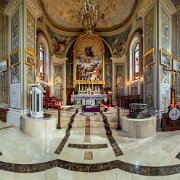
11 The Dormition of the Mother of God Church in Iași, Romania, also known as the Armenian Church, is a significant historical and architectural landmark. Located at 22 Armeană Street, this Armenian Apostolic church is dedicated to the Virgin Mary. While an inscription dated 1395 exists within the church, scholars suggest it may be a later addition, casting doubt on its authenticity. Nonetheless, historical records confirm the presence of an Armenian church in Iași dedicated to the Dormition of the Mother of God as early as the 14th century, with documented mentions between 1583 and 1586. The church underwent a significant restoration in 1803, and further repairs were carried out in 1732, 1929–1932, and post-World War II in 1946, following bombardment damage .
Architecturally, the church showcases a blend of styles reflecting its long history and the diverse influences over the centuries. Notable features include its iconostasis and choir area, which highlight the Armenian ecclesiastical art and design. The church houses three bells: a small one with a Latin inscription from 1607, a larger one inscribed in Old Church Slavonic from 1887, and another whose details are less documented. The surrounding churchyard contains headstones and graves, adding to the site's historical ambiance. Adjacent to the church is the Armenian atheneum, built in 1932, now serving as the parish house. Both the church and the atheneum are listed as historic monuments by Romania's Ministry of Culture and Religious Affairs, underscoring their cultural and historical significance
Architecturally, the church showcases a blend of styles reflecting its long history and the diverse influences over the centuries. Notable features include its iconostasis and choir area, which highlight the Armenian ecclesiastical art and design. The church houses three bells: a small one with a Latin inscription from 1607, a larger one inscribed in Old Church Slavonic from 1887, and another whose details are less documented. The surrounding churchyard contains headstones and graves, adding to the site's historical ambiance. Adjacent to the church is the Armenian atheneum, built in 1932, now serving as the parish house. Both the church and the atheneum are listed as historic monuments by Romania's Ministry of Culture and Religious Affairs, underscoring their cultural and historical significance

12 Moldovita Monastery, Romania
Moldovița Monastery, located in the historical region of Bukovina, Romania, is one of the most renowned medieval monastic complexes in the country. Built in 1532 under the rule of Prince Petru Rareș, the monastery was constructed as a replacement for an earlier 14th-century church that had been destroyed by a landslide. The monastery was part of a broader effort by Petru Rareș to strengthen Moldavian Orthodox religious and cultural identity in the face of external threats, particularly from the Ottoman Empire. Over the centuries, Moldovița Monastery has served as a religious, educational, and defensive stronghold, playing a crucial role in the region’s spiritual and artistic development. It remains an active convent, with a community of nuns maintaining its traditions and historical significance.
Architecturally, Moldovița Monastery is a prime example of the Moldavian style, which blends Byzantine, Gothic, and local Romanian elements. The church, dedicated to the Annunciation, features a three-lobed plan, a high tower above the nave, and a fortified enclosure that once served defensive purposes. One of its most remarkable features is the exterior frescoes, painted in 1537, which depict biblical scenes in vivid colors, most notably the Siege of Constantinople and the Tree of Jesse. These frescoes, still remarkably well-preserved, contribute to Moldovița’s recognition as a UNESCO World Heritage Site. The monastery's artwork, architecture, and spiritual legacy make it one of Romania’s most
Moldovița Monastery, located in the historical region of Bukovina, Romania, is one of the most renowned medieval monastic complexes in the country. Built in 1532 under the rule of Prince Petru Rareș, the monastery was constructed as a replacement for an earlier 14th-century church that had been destroyed by a landslide. The monastery was part of a broader effort by Petru Rareș to strengthen Moldavian Orthodox religious and cultural identity in the face of external threats, particularly from the Ottoman Empire. Over the centuries, Moldovița Monastery has served as a religious, educational, and defensive stronghold, playing a crucial role in the region’s spiritual and artistic development. It remains an active convent, with a community of nuns maintaining its traditions and historical significance.
Architecturally, Moldovița Monastery is a prime example of the Moldavian style, which blends Byzantine, Gothic, and local Romanian elements. The church, dedicated to the Annunciation, features a three-lobed plan, a high tower above the nave, and a fortified enclosure that once served defensive purposes. One of its most remarkable features is the exterior frescoes, painted in 1537, which depict biblical scenes in vivid colors, most notably the Siege of Constantinople and the Tree of Jesse. These frescoes, still remarkably well-preserved, contribute to Moldovița’s recognition as a UNESCO World Heritage Site. The monastery's artwork, architecture, and spiritual legacy make it one of Romania’s most
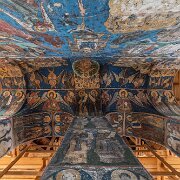
13 Humor Monastery
Mănăstirea Humor
DJ177, Mănăstirea Humorului 727355, Romania
Mănăstirea Humor is a medieval monastery located in northern Romania, in the historical region of Bukovina. Founded in 1530 by Toader Bubuiog, a high-ranking official in the court of Moldavian Prince Petru Rareș, the monastery was built on the site of an older church that had been destroyed. It became one of the most significant religious and cultural centers in Moldavia, particularly during the 16th century, a period marked by the flourishing of Orthodox monasticism. Humor Monastery is famous for its well-preserved exterior frescoes, painted in 1535, which depict biblical scenes and historical events. These frescoes, dominated by shades of red and ochre, are part of the renowned Painted Churches of Bukovina, recognized as a UNESCO World Heritage Site.
Architecturally, Mănăstirea Humor follows the Moldavian style, blending Byzantine, Gothic, and local influences. The church, dedicated to the Dormition of the Virgin Mary, features a compact, cross-shaped layout with a single tower above the nave. One of its distinctive elements is the open exonarthex, a porch-like structure typical of Bukovinian churches, which allows for the display of extensive frescoes. The monastery complex also includes defensive walls, as it once served a protective role against invasions. Inside, the frescoes continue to showcase the skill of 16th-century Moldavian artists, with vibrant colors and expressive figures depicting scenes such as the Last Judgment and the Siege of Constantinople. Despite centuries of exposure to natural elements, the monastery remains one of Romania’s most treasured architectural and artistic landmarks.
Mănăstirea Humor
DJ177, Mănăstirea Humorului 727355, Romania
Mănăstirea Humor is a medieval monastery located in northern Romania, in the historical region of Bukovina. Founded in 1530 by Toader Bubuiog, a high-ranking official in the court of Moldavian Prince Petru Rareș, the monastery was built on the site of an older church that had been destroyed. It became one of the most significant religious and cultural centers in Moldavia, particularly during the 16th century, a period marked by the flourishing of Orthodox monasticism. Humor Monastery is famous for its well-preserved exterior frescoes, painted in 1535, which depict biblical scenes and historical events. These frescoes, dominated by shades of red and ochre, are part of the renowned Painted Churches of Bukovina, recognized as a UNESCO World Heritage Site.
Architecturally, Mănăstirea Humor follows the Moldavian style, blending Byzantine, Gothic, and local influences. The church, dedicated to the Dormition of the Virgin Mary, features a compact, cross-shaped layout with a single tower above the nave. One of its distinctive elements is the open exonarthex, a porch-like structure typical of Bukovinian churches, which allows for the display of extensive frescoes. The monastery complex also includes defensive walls, as it once served a protective role against invasions. Inside, the frescoes continue to showcase the skill of 16th-century Moldavian artists, with vibrant colors and expressive figures depicting scenes such as the Last Judgment and the Siege of Constantinople. Despite centuries of exposure to natural elements, the monastery remains one of Romania’s most treasured architectural and artistic landmarks.
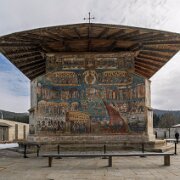
14 Voroneț Monastery, often called the "Sistine Chapel of the East," is one of Romania’s most famous medieval monasteries, located in Bukovina. Founded in 1488 by Stephen the Great, the ruler of Moldavia, it was built in just three months and three weeks as a tribute to a victory against the Ottoman Empire. The monastery quickly became an important spiritual and cultural center, housing a monastic community and a renowned school of religious art. Its most famous feature is the stunning exterior frescoes, added in 1547 during the reign of Petru Rareș. These frescoes depict biblical scenes and Orthodox Christian teachings, with the Last Judgment being the most iconic. The vibrant "Voroneț blue," a unique shade derived from natural pigments, has made the monastery world-famous, and it is now part of the UNESCO-listed Painted Churches of Bukovina.
Architecturally, Voroneț Monastery is a prime example of the Moldavian style, blending Byzantine, Gothic, and local Romanian influences. The church follows a compact, cross-shaped plan with a single, tall tower rising above the nave. It features an exonarthex (an open porch) that extends the building’s structure, allowing for additional fresco decorations. The exterior walls are almost entirely covered in intricate frescoes, which remain remarkably well-preserved despite centuries of exposure. Inside, the monastery’s interior is equally impressive, with frescoes depicting saints, biblical narratives, and apocalyptic visions.
Architecturally, Voroneț Monastery is a prime example of the Moldavian style, blending Byzantine, Gothic, and local Romanian influences. The church follows a compact, cross-shaped plan with a single, tall tower rising above the nave. It features an exonarthex (an open porch) that extends the building’s structure, allowing for additional fresco decorations. The exterior walls are almost entirely covered in intricate frescoes, which remain remarkably well-preserved despite centuries of exposure. Inside, the monastery’s interior is equally impressive, with frescoes depicting saints, biblical narratives, and apocalyptic visions.
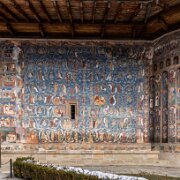
15 Voroneț Monastery, often called the "Sistine Chapel of the East," is one of Romania’s most famous medieval monasteries, located in Bukovina. Founded in 1488 by Stephen the Great, the ruler of Moldavia, it was built in just three months and three weeks as a tribute to a victory against the Ottoman Empire. The monastery quickly became an important spiritual and cultural center, housing a monastic community and a renowned school of religious art. Its most famous feature is the stunning exterior frescoes, added in 1547 during the reign of Petru Rareș. These frescoes depict biblical scenes and Orthodox Christian teachings, with the Last Judgment being the most iconic. The vibrant "Voroneț blue," a unique shade derived from natural pigments, has made the monastery world-famous, and it is now part of the UNESCO-listed Painted Churches of Bukovina.
Architecturally, Voroneț Monastery is a prime example of the Moldavian style, blending Byzantine, Gothic, and local Romanian influences. The church follows a compact, cross-shaped plan with a single, tall tower rising above the nave. It features an exonarthex (an open porch) that extends the building’s structure, allowing for additional fresco decorations. The exterior walls are almost entirely covered in intricate frescoes, which remain remarkably well-preserved despite centuries of exposure. Inside, the monastery’s interior is equally impressive, with frescoes depicting saints, biblical narratives, and apocalyptic visions.
Architecturally, Voroneț Monastery is a prime example of the Moldavian style, blending Byzantine, Gothic, and local Romanian influences. The church follows a compact, cross-shaped plan with a single, tall tower rising above the nave. It features an exonarthex (an open porch) that extends the building’s structure, allowing for additional fresco decorations. The exterior walls are almost entirely covered in intricate frescoes, which remain remarkably well-preserved despite centuries of exposure. Inside, the monastery’s interior is equally impressive, with frescoes depicting saints, biblical narratives, and apocalyptic visions.
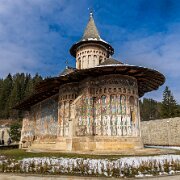
16 Voroneț Monastery, often called the "Sistine Chapel of the East," is one of Romania’s most famous medieval monasteries, located in Bukovina. Founded in 1488 by Stephen the Great, the ruler of Moldavia, it was built in just three months and three weeks as a tribute to a victory against the Ottoman Empire. The monastery quickly became an important spiritual and cultural center, housing a monastic community and a renowned school of religious art. Its most famous feature is the stunning exterior frescoes, added in 1547 during the reign of Petru Rareș. These frescoes depict biblical scenes and Orthodox Christian teachings, with the Last Judgment being the most iconic. The vibrant "Voroneț blue," a unique shade derived from natural pigments, has made the monastery world-famous, and it is now part of the UNESCO-listed Painted Churches of Bukovina.
Architecturally, Voroneț Monastery is a prime example of the Moldavian style, blending Byzantine, Gothic, and local Romanian influences. The church follows a compact, cross-shaped plan with a single, tall tower rising above the nave. It features an exonarthex (an open porch) that extends the building’s structure, allowing for additional fresco decorations. The exterior walls are almost entirely covered in intricate frescoes, which remain remarkably well-preserved despite centuries of exposure. Inside, the monastery’s interior is equally impressive, with frescoes depicting saints, biblical narratives, and apocalyptic visions.
Architecturally, Voroneț Monastery is a prime example of the Moldavian style, blending Byzantine, Gothic, and local Romanian influences. The church follows a compact, cross-shaped plan with a single, tall tower rising above the nave. It features an exonarthex (an open porch) that extends the building’s structure, allowing for additional fresco decorations. The exterior walls are almost entirely covered in intricate frescoes, which remain remarkably well-preserved despite centuries of exposure. Inside, the monastery’s interior is equally impressive, with frescoes depicting saints, biblical narratives, and apocalyptic visions.

17 Biserica “Duminica Tuturor Sfinților” din Părhăuți, located in Suceava County, Romania, is a remarkable example of 16th-century Moldavian ecclesiastical architecture. It was built in 1522 by chancellor Gavril Trotușan during the reign of Voivode Ștefăniță Vodă, the grandson of the famed Stephen the Great. Like many churches of the period, it was constructed as both a place of worship and a symbol of spiritual and political power. The church is part of the broader legacy of medieval Moldavian religious architecture that flourished during a time of cultural and artistic growth in the region. Over centuries, it has remained an active parish church and has witnessed various historical transformations, maintaining its role as a spiritual center for the local community.
Architecturally, the church is a harmonious blend of Byzantine and Gothic styles, typical of Moldavian ecclesiastical buildings. It features a rectangular plan with a semicircular apse and a distinctive tower above the nave. The exterior is modest compared to other painted churches of northern Moldavia, but it retains fragments of original frescoes that once covered the facade. Inside, the church boasts beautifully preserved interior frescoes that depict religious scenes with vivid colors and expressive figures, executed in the traditional Byzantine style. The combination of stone and brick materials, along with carved decorative elements, reflects the craftsmanship of the era and the influence of both Eastern Orthodox and Western European artistic trends. The church was listed as a historic monument and continues to be an important example of Romania’s religious and architectural heritage.
Architecturally, the church is a harmonious blend of Byzantine and Gothic styles, typical of Moldavian ecclesiastical buildings. It features a rectangular plan with a semicircular apse and a distinctive tower above the nave. The exterior is modest compared to other painted churches of northern Moldavia, but it retains fragments of original frescoes that once covered the facade. Inside, the church boasts beautifully preserved interior frescoes that depict religious scenes with vivid colors and expressive figures, executed in the traditional Byzantine style. The combination of stone and brick materials, along with carved decorative elements, reflects the craftsmanship of the era and the influence of both Eastern Orthodox and Western European artistic trends. The church was listed as a historic monument and continues to be an important example of Romania’s religious and architectural heritage.
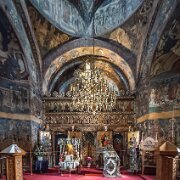
18 Voroneț Monastery, often called the "Sistine Chapel of the East," is one of Romania’s most famous medieval monasteries, located in Bukovina. Founded in 1488 by Stephen the Great, the ruler of Moldavia, it was built in just three months and three weeks as a tribute to a victory against the Ottoman Empire. The monastery quickly became an important spiritual and cultural center, housing a monastic community and a renowned school of religious art. Its most famous feature is the stunning exterior frescoes, added in 1547 during the reign of Petru Rareș. These frescoes depict biblical scenes and Orthodox Christian teachings, with the Last Judgment being the most iconic. The vibrant "Voroneț blue," a unique shade derived from natural pigments, has made the monastery world-famous, and it is now part of the UNESCO-listed Painted Churches of Bukovina.
Architecturally, Voroneț Monastery is a prime example of the Moldavian style, blending Byzantine, Gothic, and local Romanian influences. The church follows a compact, cross-shaped plan with a single, tall tower rising above the nave. It features an exonarthex (an open porch) that extends the building’s structure, allowing for additional fresco decorations. The exterior walls are almost entirely covered in intricate frescoes, which remain remarkably well-preserved despite centuries of exposure. Inside, the monastery’s interior is equally impressive, with frescoes depicting saints, biblical narratives, and apocalyptic visions.
Architecturally, Voroneț Monastery is a prime example of the Moldavian style, blending Byzantine, Gothic, and local Romanian influences. The church follows a compact, cross-shaped plan with a single, tall tower rising above the nave. It features an exonarthex (an open porch) that extends the building’s structure, allowing for additional fresco decorations. The exterior walls are almost entirely covered in intricate frescoes, which remain remarkably well-preserved despite centuries of exposure. Inside, the monastery’s interior is equally impressive, with frescoes depicting saints, biblical narratives, and apocalyptic visions.
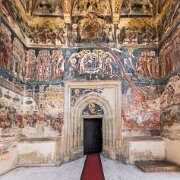
19 Moldovita Monastery, Romania
Moldovița Monastery, located in the historical region of Bukovina, Romania, is one of the most renowned medieval monastic complexes in the country. Built in 1532 under the rule of Prince Petru Rareș, the monastery was constructed as a replacement for an earlier 14th-century church that had been destroyed by a landslide. The monastery was part of a broader effort by Petru Rareș to strengthen Moldavian Orthodox religious and cultural identity in the face of external threats, particularly from the Ottoman Empire. Over the centuries, Moldovița Monastery has served as a religious, educational, and defensive stronghold, playing a crucial role in the region’s spiritual and artistic development. It remains an active convent, with a community of nuns maintaining its traditions and historical significance.
Architecturally, Moldovița Monastery is a prime example of the Moldavian style, which blends Byzantine, Gothic, and local Romanian elements. The church, dedicated to the Annunciation, features a three-lobed plan, a high tower above the nave, and a fortified enclosure that once served defensive purposes. One of its most remarkable features is the exterior frescoes, painted in 1537, which depict biblical scenes in vivid colors, most notably the Siege of Constantinople and the Tree of Jesse. These frescoes, still remarkably well-preserved, contribute to Moldovița’s recognition as a UNESCO World Heritage Site. The monastery's artwork, architecture, and spiritual legacy make it one of Romania’s most
Moldovița Monastery, located in the historical region of Bukovina, Romania, is one of the most renowned medieval monastic complexes in the country. Built in 1532 under the rule of Prince Petru Rareș, the monastery was constructed as a replacement for an earlier 14th-century church that had been destroyed by a landslide. The monastery was part of a broader effort by Petru Rareș to strengthen Moldavian Orthodox religious and cultural identity in the face of external threats, particularly from the Ottoman Empire. Over the centuries, Moldovița Monastery has served as a religious, educational, and defensive stronghold, playing a crucial role in the region’s spiritual and artistic development. It remains an active convent, with a community of nuns maintaining its traditions and historical significance.
Architecturally, Moldovița Monastery is a prime example of the Moldavian style, which blends Byzantine, Gothic, and local Romanian elements. The church, dedicated to the Annunciation, features a three-lobed plan, a high tower above the nave, and a fortified enclosure that once served defensive purposes. One of its most remarkable features is the exterior frescoes, painted in 1537, which depict biblical scenes in vivid colors, most notably the Siege of Constantinople and the Tree of Jesse. These frescoes, still remarkably well-preserved, contribute to Moldovița’s recognition as a UNESCO World Heritage Site. The monastery's artwork, architecture, and spiritual legacy make it one of Romania’s most
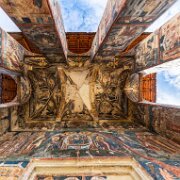
20 Moldovita Monastery, Romania
Moldovița Monastery, located in the historical region of Bukovina, Romania, is one of the most renowned medieval monastic complexes in the country. Built in 1532 under the rule of Prince Petru Rareș, the monastery was constructed as a replacement for an earlier 14th-century church that had been destroyed by a landslide. The monastery was part of a broader effort by Petru Rareș to strengthen Moldavian Orthodox religious and cultural identity in the face of external threats, particularly from the Ottoman Empire. Over the centuries, Moldovița Monastery has served as a religious, educational, and defensive stronghold, playing a crucial role in the region’s spiritual and artistic development. It remains an active convent, with a community of nuns maintaining its traditions and historical significance.
Architecturally, Moldovița Monastery is a prime example of the Moldavian style, which blends Byzantine, Gothic, and local Romanian elements. The church, dedicated to the Annunciation, features a three-lobed plan, a high tower above the nave, and a fortified enclosure that once served defensive purposes. One of its most remarkable features is the exterior frescoes, painted in 1537, which depict biblical scenes in vivid colors, most notably the Siege of Constantinople and the Tree of Jesse. These frescoes, still remarkably well-preserved, contribute to Moldovița’s recognition as a UNESCO World Heritage Site. The monastery's artwork, architecture, and spiritual legacy make it one of Romania’s most
Moldovița Monastery, located in the historical region of Bukovina, Romania, is one of the most renowned medieval monastic complexes in the country. Built in 1532 under the rule of Prince Petru Rareș, the monastery was constructed as a replacement for an earlier 14th-century church that had been destroyed by a landslide. The monastery was part of a broader effort by Petru Rareș to strengthen Moldavian Orthodox religious and cultural identity in the face of external threats, particularly from the Ottoman Empire. Over the centuries, Moldovița Monastery has served as a religious, educational, and defensive stronghold, playing a crucial role in the region’s spiritual and artistic development. It remains an active convent, with a community of nuns maintaining its traditions and historical significance.
Architecturally, Moldovița Monastery is a prime example of the Moldavian style, which blends Byzantine, Gothic, and local Romanian elements. The church, dedicated to the Annunciation, features a three-lobed plan, a high tower above the nave, and a fortified enclosure that once served defensive purposes. One of its most remarkable features is the exterior frescoes, painted in 1537, which depict biblical scenes in vivid colors, most notably the Siege of Constantinople and the Tree of Jesse. These frescoes, still remarkably well-preserved, contribute to Moldovița’s recognition as a UNESCO World Heritage Site. The monastery's artwork, architecture, and spiritual legacy make it one of Romania’s most
Churches